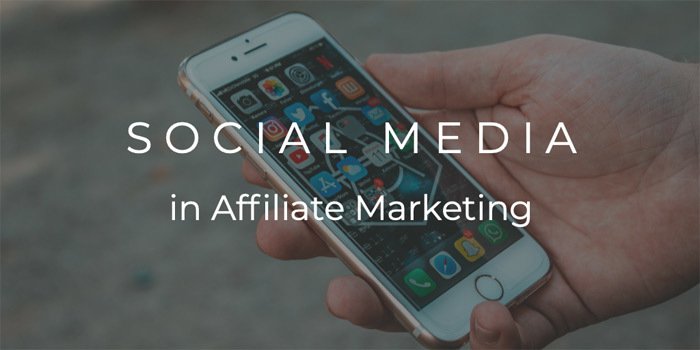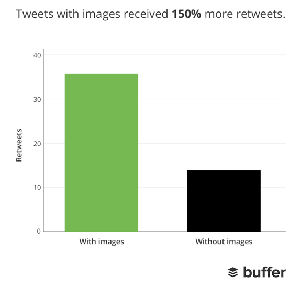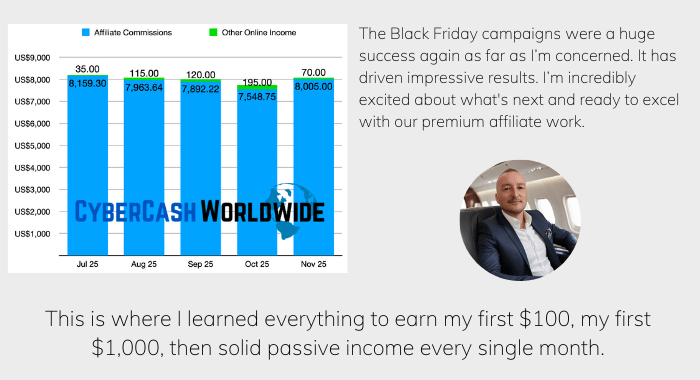Social media in affiliate marketing is a hit-and-miss. In fact, if you are thinking about opening a new account for the sake of promoting affiliate products, you may be wasting your time. Every day, god knows how many thousands of people open a new account, start to follow whoever is visible randomly, and repeatedly post the same message.
Is it worth the effort that way, and are they making money? ...I really doubt it.

Did You Know?
- More than 90% of affiliate marketers use social media as a key strategy.
- Social media accounts for approximately 15-20% of the total revenue in affiliate marketing.
- Around 65% of affiliate marketers link up with influencers to boost sales.
Is Social Media Marketing Easy?
Promoting your affiliate products on social media is certainly simple, quick, and easy. But how you can actually make money from it relies on...as you guessed it, the quality of engagement with your followers and with how many of them.
It's a social network, not a sell/buy marketplace. Many people use Instagram or Pinterest in search of nice things to buy. But others use them to display their likes, looking for others who have the same interests and to connect. And there are millions of them if not billions. We need to get a little more work done to draw more attention from the 'general public'.
What Makes Things Boring or 'Fake'?
If you are new to social media for affiliate marketing purposes and care to pay attention to what other marketers in the same niche are up to, soon you'll start to notice different posting patterns. You know, some posts look so bland and 'disconnected'.
Learn wisdom by the follies of others - what looks boring or fake to you is precisely what you shouldn't do to others. The following posting types are typical examples - you should avoid taking them seriously if you see them, and you shouldn't publish such posts either.
Similar cases apply when you receive a direct message from someone for the first time. Some types of messages that cannot be possibly taken seriously include;

I'm not reading that!
By gathering all that 'fake behaviors' from others, we can figure out what we should not do.
#1 Make Your Account Look Real
Show yourself in the profile photo if you can, but if you really don't want to, make your profile a little more visually approachable. Landscape images (as in mountains and beaches) or photos of conference attendees are dull. Fill in a brief bio. Don't just say "Affiliate marketer" but say what you have been or achieved in the past few years.
Did You Know?
- About 55% of consumers trust the products endorsed by their favorite social media personalities.
- Social media campaigns in affiliate marketing see an average conversion rate of 4-6%.
- Marketers report an average of 130% ROI from social media affiliate campaigns.
#2 Publish Posts Manually
Auto-recurring posts are okay only if they appear occasionally. Publish your own posts manually and re-share / retweet to fill in the gap between the robotic posts.
Sure, automation tools are great and they save time, but they can't quite match the human touch. Here's why manually publishing posts can be a game-changer:
- Personalization: Each post can be tailored to fit the mood and trends of the moment.
- Timeliness: You get to choose the perfect time to post, which can increase visibility and engagement.
- Authenticity: Your followers can tell when you're genuinely behind the screen, and this authenticity builds trust.
People connect with people, not robots. By manually posting, you're showing your followers that there's a real person behind the account, someone who cares enough to take the time. This personal connection is gold in affiliate marketing, right?
#3 Don't Start Promoting Right Away

Imagine you walk into a bar where no one knows you. The customers enjoy themselves drinking when you barge in and intervene in their conversations by trying to sell some stuff. Opening a social media account and bombarding with promotional materials is just like that.
Still, the people in the bar may show interest if you're selling the right stuff - hotdogs and chips, perhaps (though you'd be thrown out by the security within minutes for sure). How about selling an insurance policy? Absolutely nobody in the bar would be interested.
Jumping straight into promoting products can be tempting, but it's like asking someone to marry you on the first date, you know? Building a relationship with your audience first is crucial. Here's how you can do that:
- Share Value: Start by sharing content that's useful and interesting to your audience. This could be tips, insights, or even funny anecdotes related to your niche.
- Tell Your Story: People love stories. Share your journey, the ups and downs, and how the products you'll eventually promote fit into your life.
- Listen and Learn: Pay attention to the comments and messages you receive. This feedback is invaluable for understanding what your audience really wants.
By taking time to establish yourself as a relatable and trustworthy figure, you're laying the groundwork for successful promotions later on. People are more likely to buy from someone they feel connected to, aren't they?
#4 Interaction
Now, let's talk about interaction, but not in the typical 'engage with your audience' kind of way. It's about building genuine connections. Here's what you can do:
- Respond to Comments: Take the time to respond thoughtfully to comments. This shows that you value your followers' opinions.
- Join Conversations: Don't just talk at your audience; talk with them. Join in on conversations happening in your niche.
- Ask Questions: Get curious about your followers. Ask them questions to understand their needs and preferences better.
This interaction creates a community feeling around your social media presence. It's about making your followers feel seen and heard, which in turn makes them more open to your affiliate promotions, you see?
#5 Build Followers

Would you agree that generally, the more followers/friends you have, the more your account should look credible? Someone approaches you and says "Try this new app, it works and it's free!" If that person has thousands of followers (and also a variety of posts), you might be tempted to click the link to take a look. But if that person has very few, then who the hell is this? Perhaps you'll take the message less seriously. Unless the product looks really appealing.
The sad fact is, that the face value counts up to a certain level. People pay more attention to an account with 20,000 followers than an account with 20 followers in the first instance. Whether the followers are bots or inactive followers. For that reason, many users use some third-party follow/unfollow apps to help them grow their 'apparent audience' quickly.
#6 Know When To "Enter" Twice
I'm referring to the space between paragraphs! A lengthy message in a single big paragraph is an eyesore. Firstly try to get to the point briefly. If it needs a long explanation, write it section by section. It's a social network, people barely spare time to read your whole story unless they have absolutely nothing better to do!
#7 Don't Use Bombastic Words
It's all about copywriting techniques, and it's not something we can do to learn overnight. It's hard to create a short but compelling social media post content...
But if you try to mimic some dumb old commercial messages ("This revolutionary device is gonna change your LIFE!"), it will only make you look more unreal, cheap, and deceptive. Be as honest as you can when trying to send a message across. And don't forget to make it short!
#8 Use Visual Images

According to the result of a tweet test carried out by Buffer, tweets with images received 18% more clicks than those without. Tweets with images received 89% more favorites and 150% more retweets.
There's no surprise here. When you scroll down your newsfeed, your eyes will naturally fall on images, then inevitably, they'll be likely to skip through plain messages with no image.
So you see how important to attach an image (or several images) especially when you publish an affiliate promotion post. The image can be the actual photo of the products you promote or can be a screenshot of the seller's webpage.
#9 Log On Daily
From the marketing point of view, a social media account that's not kept up daily is almost not worth existing. And it's not just about broadcasting your content but about reacting to the posts by others and replying to messages.
That's what the social media management services such as Hootsuite and Buffer are for. You can schedule your own posts using these apps (so that you can manage the interval between each post), but you should still log on to your social account and see what others are up to.
It is hard - impossible! - to maintain all the social accounts if you have more than a few. You don't want them to rule your day. X has a lot of negativity now, so you can probably focus on a couple of accounts, say Instagram and TikTok in the beginning, and then when you feel more comfortable you can explore other social networks. Alternatively, you can tell your audience to visit your other accounts. For example in your Instagram profile, you can say "I cannot reply to your DMs. Please visit my Facebook group...(URL)".
Did You Know?
- Pinterest's Role: 25% of affiliate marketers find Pinterest effective for their campaigns.
- TikTok's Rise: In the last year, TikTok has seen a 200% increase in affiliate marketing activities.
- LinkedIn's Influence: For B2B affiliate marketing, LinkedIn contributes to approximately 15% of successful conversions.
- Facebook's Role: Nearly 80% of affiliate marketers consider Facebook the most effective social platform for their campaigns.
- Instagram's Growth: About 70% of brands believe Instagram is highly significant for their affiliate campaigns.
- YouTube's Power: 60% of consumers have made a purchase after watching a product video on YouTube.
#10 Have Your Own Website!
There are two benefits - significant benefits - to have your own website.
One is about your social profile itself. A profile with a website URL is much more credible than one without. Even as an affiliate marketer, the website existence will tell your audience/followers that you are a brand, you see? They can click the link in your profile and know more about you much quicker. Without a website, they'd have to scroll down to view your posting history and guess who you really are.
The other benefit is your promotional postings. Inevitably without a website, all you can do is promote affiliate products and direct your followers to the affiliated site day-in, day-out. You're not gaining anything unless someone makes a purchase and you make a commission from it. And you can only annoy your followers if you promote the same product two days in a row. If they weren't interested in the post (affiliate product) that you published yesterday, they're not showing interest in exactly the same post you published today.
Instead, you can use your social network to announce your website (blog) updates. Your audience will click the link and visit your site, which means social media becomes a source of traffic too.

#11 Use A Link Shortener
You shouldn't really place your affiliate link in your social media post, because it usually;
- Looks long...
- And ugly.
- Easily recognizable by anyone that it's an affiliate link.
- Your affiliate ID is visible, shown at the end of the URL (something like https://productsite.com/?ref=12345).
Instead, you might want to use a link shortener such as Bitly or TinyURL to mask the unattractive link.
But people still tend to be apprehensive about clicking a bit.ly link. If you have a WordPress website, use a link shortener plugin such as Pretty Links to redirect your affiliate link. The link you place in your social post will look like https://yoursite.com/product, and that will work great for your website brand promotion purposes as well.
#12 Only Promote The Products You Believe In
Think about a situation where you recommend a product to someone and convince them to buy it, you should...
- Know the product well.
- Be able to explain why you recommend it.
- Actually convince them, i.e. by using words that they understand.
This is so simple and obvious, but if you don't believe in, or at least like the product, there's no way others will believe what you say.
If you randomly keep posting your affiliate ads, hoping people will catch some of them and decide to buy...the chances are slim. You're not only wasting your time but you may be lowering your reputation by doing that.
#13 Don't Spare Too Much Time For Other Marketers!

You can follow other affiliate marketers in the social network, contact them, and learn what products they promote and how they do it... In an ideal world.
In reality, most affiliate marketers don't give a damn about what you are promoting. Almost 10 out of 10 marketers who approach you only have an intention to sell. They'd ask you what kind of niche you are in, for example. As soon as you give them an answer, the next reply you get from them would be either;
- "I can help you promote your business for a fee." or
- "Are you interested in cryptocurrencies?"...which means "I actually don't care about what you do. My product is better. Buy it."
It's best to ignore messages from other marketers. Okay, I'll rephrase it - don't spend too much time with them. Because if you react to them, very few of them will back down easily. Say "No thanks, I'm good" and then they'll say "May I ask you the reason why you're not interested?"
Do I sound bitter? Yes, I might just. But you really cannot afford to waste time checking other affiliate marketers' recommendations via social media. They're not helping you and you'd rather spend more time to improve your social media marketing strategies.
Social Media in Affiliate Marketing
I hope the above tips will help you save time, find better ways to engage with other users on social networks and gain trust from them in time. If you wish to build up to 2 websites for free and receive niche affiliate marketing training, you can start from here;



Hi Ray, how are you? Thank you for your awesome post. I was wondering is there required to have a business for work with a social network, Facebook for example?
Hi Shuvo, thanks for your comment. I didn’t quite get that question…should a business have social network accounts (FB pages)? Yes, and should the pages be updated regularly? Yes!
Great tips. Social Media has been an amazing tool to successfully open more doors. It’s important to be transparant in the beginning then you don’t need to convince anybody.
Hi Arslan, thanks for your comment. Yes you’re absolutely right!